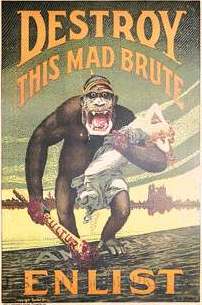
During World War I, the German threat was depicted as a mad, marauding gorilla with a bloody club.

Recently, an American political cartoon asked the question, "What Would Mohammed Drive?" and answered it with a drawing of a man dressed in Muslim garb driving a rental truck with a missile hanging out the back.
"For most human beings, it takes an awful lot to allow them to kill another human being," said Anthony Pratkanis, a psychology professor at the University of California, Santa Cruz. "The only way to do it is to justify the killing, to make the enemy look as evil as possible."
Propaganda, both by governments and the private media, has evolved over the years as media has evolved. But, some say, the principle remains the same.
"The secret in propaganda is that when you demonize, you dehumanize," said James Forsher, a film historian and documentary filmmaker who has studied propaganda films, and who is an assistant professor of mass communications at California State University, Hayward.
"When you dehumanize, it allows you to kill your enemy and no longer feel guilty about it," he said. "That is why during World War II, a lot of caricatures became animals. … You can kill a monkey a lot more easily than you can kill a neighbor."
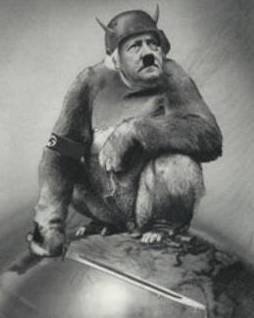

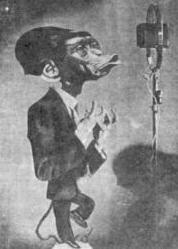
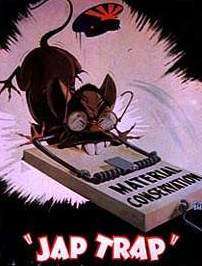

Tales of atrocities also can dehumanize, as readers of William Randolph Hearst's newspapers learned when they got whipped up for the Spanish-American war with fake stories and sketches of Spanish atrocities that probably never happened. Arguably, it set a pattern for phony or embellished American wartime propaganda that would last at least through the Gulf War.
The Spanish-American War also delivered, perhaps for the first time, films gloriously recreating war events, Forsher said, and, "The government looked at it and went, 'Wow.'"
For World War I, the United States government created a propaganda office, and made sure to deploy movies in its propaganda arsenal. A cooperative Hollywood responded with films such as The Kaiser, the Beast of Berlin, To Hell With the Kaiser! and D.W. Griffith's Hearts of the World, which showed Germans throwing babies out windows, Forsher said.
On the other hand, an unfortunate group of filmmakers in 1917 put out The Spirit of '76, an epic about the American Revolution.
"Bad timing, as we were joining the war on the side of the British," Forsher said. "The Americans confiscated every print and threw the producer in jail."
Much of World War I's demonization propaganda seems blunt to modern eyes. A U.S. Army recruitment poster depicted a crazed gorilla wearing a German spiked war helmet, holding a bloody club in one hand and a half-ravished woman in the other, and stepping onto the shores of America. It said, "Destroy this Mad Brute."
In fact, the anti-German propaganda began even before America entered the war.
"In 1914, when war broke out, within weeks the image of Germans and Germany became filled with every symbol of barbarism that people could think of," said Jay Winter, a Yale University history professor whose specialty is World War I. "It had to be something where the war was the sons of light against the sons of darkness. And the reason was to muzzle dissent."
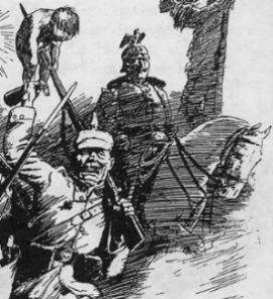
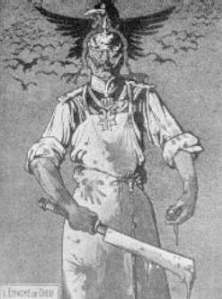
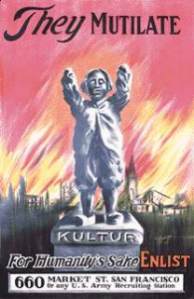
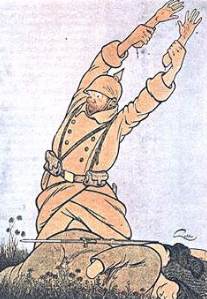
"There were Belgians and French who were killed as the Germans invaded," Winter said. "Within days, the image wasn't good enough. It had to be amplified by children having their hands chopped off and women having their breasts chopped off."
The problem was, it wasn't true, Winter said. Nor, apparently, was another story that World War I's Germans were boiling down enemies to make soap, said Pratkanis, co-author of Age of Propaganda: The Everyday Use and Abuse of Persuasion.
Nevertheless, "This mobilization of hatred was so effective and powerful, that during the Second World War it made it difficult to believe the stories about the Holocaust," Winter said.
World War II posters showed shadowy Nazism looming over America and its citizens, and racist stereotypes of the Japanese with thick glasses, buck teeth, and sometimes animal-like features.

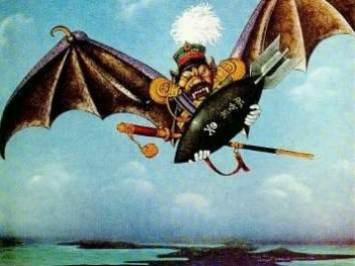

One amateur poster showed a stylized Japanese man carrying a limp, naked white woman over his shoulder and was emblazoned with the words, "This Is the Enemy."
A poster produced by an American corporation showed a giant Hitler with a handgun and a Japanese man with a bloody knife looming on either side of the globe, with North America between them. "Warning!" the poster said. "Our Homes Are In Danger Now!"
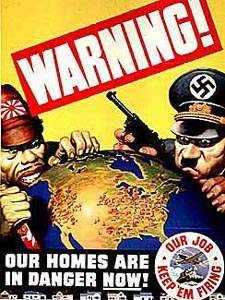

Hollywood again spooled out patriotic films. This time, they included animated shorts that portrayed the Germans and, especially, the Japanese as ridiculous or racist caricatures, said Stefan Kanfer, author of Serious Business: Cartoons and America, from Betty Boop to Toy Story. Often, the cartoons featured well-known animation characters, such as Popeye in Scrap the Japs, he said.
Some believe such caricatures, and the racist attitudes they fostered, allowed America to tolerate the internment of Japanese-Americans during the war.
"I think our sensibilities are a little different, but not that different," Forsher said. "I don't think we're showing an Arabic population carrying knives and stabbing Americans. But then again, who is the villain in the new James bond film? North Koreans."
"Hollywood, when they search for a plot line, you've got to have an enemy," he said.
Some believe the Sept. 11 attacks, hostility toward Iraq and Iran, and an alliance with Israel, has caused significant backlash against Arab-Americans and Arabs around the world.
"I think the demonization of Islam and the Arab world is identical to what happened 100 years ago," Winter said. "The Arab is now a stock figure, a caricature, a symbol of fanaticism, of infinite cruelty and no regard for human rights."
"If things turn nasty [with Iraq], God knows what's going to happen to them," Forsher said. "It worries me. It worries me for the country and for Americans who have Middle Eastern ancestry."
The Cold War also produced propaganda films, Forsher said, though they often took the form of metaphorical science fiction films like Invaders from Mars, about alien invaders wanting to consume American civilization. The tone contrasted with films about the Russians from World War II.
"When we were with the Russians, there were a number of films to show they weren't so bad," he said. "Then five years later, it was the opposite."
The Korean and Vietnam wars may have seen less Hollywood propaganda, Forsher said, though both produced patriotic films, including The Green Berets starring John Wayne.
"It has to do with the studio system," Forsher said. "Back in the late teens and the early '20s, Hollywood, which was very new at that point, was deadly afraid of censorship. … They went out of their way to help the government, to work with the government with sort of an agreement of we'll work with you if you leave us alone."
"That started breaking down in the early to mid-'60s," he said. "At this point, they're comfortable the government is not going to step in and tell them what to put in as far as content."
Vietnamese leader Ho Chi Minh also fell into the Cold War's anti-Communist rogues' gallery.
"You need somebody to hate," Winter said. "It was true of Hitler, it was true of the Kaiser, it was true of Ho Chi Minh."
And it was true of Saddam Hussein during the Gulf War. "The Butcher of Baghdad" was compared to Hitler and demonized as a voracious spider in cartoons.
Even before the Gulf War, the American campaign to invade Panama and seize its dictator, Manuel Noriega, a.k.a. "Pineapple Face," on drug charges, proved the idea of demonizing America's enemies was not dead. As Noriega was dragged out of Panama to face charges in Miami, word leaked out about his portrait of Adolph Hitler, his pornography collection, his bloody voodoo ceremonies, and the red underwear he allegedly wore to ward off his enemies' "evil eye."
And it was not hard for America to demonize its enemies after it was attacked on Sept. 11, 2001. President Bush took to calling Osama bin Laden "the evil one," and said he was wanted "dead or alive," like a mass killer on a Wild West poster.
The "What Would Mohammed Drive?" cartoon came more than a year later, playing off the "What Would Jesus Drive?" anti-SUV campaign. It's creator, Doug Marlette, wrote in the Jewish World Review that it was not meant to demean Arabs, Muslims or even Mohammed, but rather to attack "the distortion of their religion by murderous fanatics and zealots" acting in the name of Islam.
Saddam again is the object of American ire, though subhuman depictions of Iraqis seem rare or nonexistent.
"The kind of stories that are being portrayed today about Iraq are a little different than the ones that were done, say, in World War I," Pratkanis said. "World War I was about the people of Germany, whereas the ones today are what is known as the blacktop illusion. The images in the news media show the people of Iraq as decent people, and that the evil resides at the top, in Saddam Hussein."
Winter said that will make it easier for Americans to understand kind treatment of Iraqis after Saddam is gone.
"Right now, the idea is that one either totally evil or totally insane leader, or both, is using murder and torture to dominate a population that can be liberated by a benevolent West," Winter said. "In order to fulfill the policy of regime change... it is necessary to separate a population that will be liberated... from the population that is oppressing them."
Few say they doubt Saddam is evil, but how much about the allegations about him are true? It's often not easy to tell until years after the fact.
"That's part of the rub," Pratkanis said. "In hindsight, when you know it's false, it looks over the top and outrageous."
Copyright © 2005 ABC News Internet Ventures
weiter zu Indianer, Insekten, Japaner
zurück zu Die [un]schöne Welt der Illusionen
heim zu Reisen durch die Vergangenheit